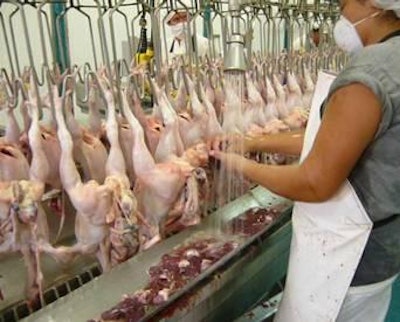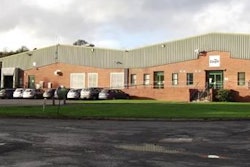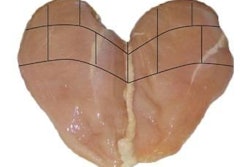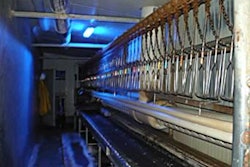
The poultry industry is constantly reminded of the need to meet the growing demand for food, yet it should never be forgotten that resources are finite. Water is increasingly scarce and valuable; cultivable land is in shorter supply; and the impact of climate change is a growing reality.
Because of its efficiency, the poultry industry is emerging as the No. 1 supplier of sustainable animal protein -- be it in the form of poultry meat or eggs -- yet there are still examples where the industry does not run as efficiently as it could or make the best use of its resources. One such example is the use of water in poultry processing plants; however, there are numerous ways in which savings can be made.
Infrastructure
At the start of the processing chain, water is used for washing, and through the addition of suitable products, the disinfection of birds. Any equipment used for these processes should supply sufficient volumes of water but not waste it. However, in the day-to-day functioning of the processing plant, reality does not always match the ideal.
The equipment used for carcass washing may be located in the scalding, plucking and evisceration areas of the processing plant, and may simply comprise a traditional domestic showerhead. This results in high consumption of drinking-quality water, which is expensive to produce.
This same type of showerhead can also be seen during evisceration and, in the worst cases, nothing more than a half inch hose is used, and the water supply is never turned off.
Leaking pipes and hoses
At some biosecurity stations, hand and boot washing facilities do not supply only the water needed, so once again, water is wasted. Similarly, the pipelines used for cleaning the processing plant may not be in a good state of repair and may be without adequate control valves.
Operational factors
In some processing plants, as soon as the daily shift starts, overhead conveyors, scalders, pluckers and washing equipment are all brought on-line, including the evisceration equipment. It can take up to eight minutes for birds to reach the washing areas, so bringing these operations into use immediately at the start of the daily shift will result in water wastage each and every day.
An additional issue that may arise is the overfilling of scalders. When the blowers start to work and the water is agitated, spillage will occur. This can mean that more water must be added in addition to the 1 liter per bird that enters the scalder if birds are to be submerged to the necessary depth.
In some processing plants, the overhead evisceration conveyor is started as soon as birds reach this area. The problem with this is that valves controlling the sprayers and carcass washers immediately open, meaning that water is wasted before the chicken arrives at the first work station where the vent is cut.
At some gizzard-peeling stations where there are two or more workplaces, water valves are not independently controllable. As a consequence, if one workplace is in operation, all sprinkler valves that supply water to the rollers come into operation. In those instances, a solution is rarely sought.
A similar situation arises when filling the chillers with carcasses and offal, and in some plants, the initial water level is above the paddle shaft and screw. With the addition of ice, the level rises further. Once the blowers start, the resultant turbulence wastes yet more expensive water, and remember that money has been spent to chill the water. As is the case with scalders, water must be added to maintain the correct level - normally 1 liter per carcass entered.
Poorly repaired joints can be another problem in processing plants, and small holes can be another route through which water is lost from scalders and chillers. This continual dripping and leaking from the moment the pipes are filled through to the end of the shift, can amount to several liters of water per day.
Removal of the adjustable control valves, designed to offer variable water pressure, on hoses used for washing can also be another problem, and this practice is often overlooked by plant managers. In an attempt to restore control, workers often use their thumbs to regulate water pressure, but this is a far from efficient approach. An additional problem occurs when detergent is being applied to the plant; without the end-of-line valve, workers must go to the general control to shut off the water supply, but do not always do so.
Reducing water waste
A culture needs to be created that all work must be carried out quickly and well to avoid waste of any kind, and this includes the connection of pipes, hoses and the carrying out repairs. Another challenge for plant managers would be to organize a more staggered start for each process at the start of the shift, and to insist on greater accuracy. This could result in a reduction in energy consumption, an increase in the working life of bearings, a reduction in wasted water through the proper adjustment of air pressure used by the blowers, an overall lowering in amount of water used per processed chicken, etc.
While not widely known, avian blood takes longer to coagulate than mammalian blood, and this should be reflected in the design and angle of the blood channel so that only enough water as is needed is used to help move the blood to where it is temporarily stored. This can result in a substantial saving of liters used per processed bird.
Using correct spray nozzles in all washers
Flute-type sprinklers should be used for evisceration, particularly when performing the vent cut and the removal of the viscera, heart, livers and gizzard.
The water pipework system should resemble that for compressed air, with quick couples and pressure guns.
Biosecurity stations should have movement sensors that control the flow of water for hand and boot washing. Perhaps it is worth considering how many hospitals now approach hand-washing -- a disinfectant gel that can be applied to the hands and arms without water.
Water reuse, rainwater
Proper treatment of wastewater can lead to it being reused. For example, it can be reused for cleaning floors in the bird reception area, where trucks wait to unload birds, in lavatories, for supplying boilers and cooling towers.
In some processing plants, rainwater is collected, treated and stored. Depending on quality, it can also be used for processing or industrial uses.
By recycling wastewater or collecting rainwater, the total volume of fresh water used can be reduced for washing equipment and the plant by an average of 6 liters per bird. When large volumes are processed every day, the annual savings in operating costs are significant and will contribute to the competitiveness of the final product.

















